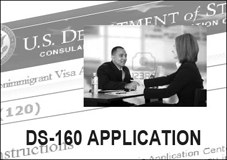|
Understanding the Visa Application Fee Structure in the US: A Step-by-Step BreakdownPlanning to visit the United States? Navigating the visa application process can feel like stepping into a maze of fees and requirements. But fear not! We're here to unravel the complexities and provide you with a step-by-step breakdown of the visa application fee structure in the US. In this comprehensive guide, we'll walk you through the various fees associated with visa applications, from the nonimmigrant visa application fee to the immigrant visa fee. Whether you're applying for a tourist visa, student visa, or work visa, understanding the fee structure is crucial for a smooth and hassle-free application process. We'll also shed light on important considerations, such as fee waivers and refunds, that can help you save both time and money. So, let's dive in and demystify the visa application fee structure, empowering you to make informed decisions and embark on your journey to the land of opportunities with confidence.
Overview of the Visa Application Fee StructureBefore we delve into the specifics, let's start with a high-level overview of the visa application fee structure in the US. The fee structure varies depending on the type of visa you are applying for, and it's important to understand the different components involved. Generally, there are two main types of visa application fees: nonimmigrant visa application fees and immigrant visa fees. The nonimmigrant visa application fee is applicable for temporary visitors to the US, such as tourists, students, and temporary workers. On the other hand, the immigrant visa fee is for individuals seeking permanent residence in the US through family sponsorship, employment, or other immigration categories. It's crucial to identify the correct visa category and understand the associated fees to ensure a successful application process.
Step-by-Step Breakdown of the Visa Application Fee Payment ProcessNow that we have a basic understanding of the fee structure, let's explore the step-by-step breakdown of the visa application fee payment process. The process may vary slightly depending on the type of visa and the country from which you are applying. However, the general steps remain the same. 1. Determine the visa category: The first step is to identify the appropriate visa category for your visit. Common nonimmigrant visa categories include B-1/B-2 for business and tourism, F-1 for students, and H-1B for temporary workers. Immigrant visa categories include family-sponsored, employment-based, and diversity visas. 2. Complete the visa application : Once you have determined the visa category, you will need to complete the appropriate visa application form. This can be done online or through a paper application, depending on the specific instructions provided by the US embassy or consulate. 3. Pay the visa application fee: After completing the visa application, you will be required to pay the visa application fee. The fee can be paid online using a credit or debit card, or through alternative payment methods specified by the US embassy or consulate. It's important to note that the fee is non-refundable, even if your visa application is denied. 4. Schedule the visa interview: Once the visa application fee is paid, you can schedule an appointment for a visa interview at the US embassy or consulate. The interview is a crucial step in the application process and allows the consular officer to assess your eligibility for the visa. 5. Attend the visa interview: On the day of the interview, make sure to bring all the required documents, including the visa application confirmation page, passport, and supporting documents. The consular officer will ask you questions about your purpose of travel, ties to your home country, and other relevant information. 6. Track your visa application: After the interview, you can track the status of your visa application online. The processing times may vary depending on the workload at the embassy or consulate, so it's important to plan accordingly. By following these step-by-step instructions, you can navigate the visa application fee payment process with ease and confidence.
Common Misconceptions about Visa Application FeesWhen it comes to visa application fees, there are several common misconceptions that can lead to confusion. Let's address some of these misconceptions to ensure a clear understanding of the fee structure. 1. Visa application fees are the same for all countries: This is not true. The visa application fees may vary depending on the country from which you are applying. It's important to consult the specific fee schedule provided by the US embassy or consulate in your country. 2. Paying higher fees increases the chances of visa approval: The visa application fee is not directly linked to the approval or denial of your visa application. The decision is based on various factors, including your eligibility, supporting documentation, and the consular officer's assessment during the interview. 3. The visa application fee covers all costs: While the visa application fee covers the processing of your application, it does not include other associated costs, such as medical examinations, document translations, or travel expenses. It's essential to have accurate information and dispel any misconceptions to avoid unnecessary confusion and make informed decisions during the visa application process.
Factors That May Affect the Visa Application FeeThe visa application fee is not a fixed amount and can vary based on certain factors. Here are some factors that may affect the visa application fee: 1. Visa category: Different visa categories have different fee structures. For example, the fee for a tourist visa may be different from that of a student visa or a work visa. It's important to check the specific fee schedule for your visa category. 2. Exchange rates: If you are paying the visa application fee in a currency other than US dollars, the exchange rate at the time of payment may affect the amount you pay. 3. Fee waivers: In certain circumstances, you may be eligible for a fee waiver or a reduced fee. This is typically applicable to specific visa categories, such as applicants participating in government-sponsored programs or certain family members of US citizens or permanent residents. Understanding these factors can help you anticipate the visa application fee and plan your finances accordingly.
Tips for Saving Money on Visa Application FeesApplying for a visa can be a costly process, but there are ways to save money on visa application fees. Here are some tips to consider: 1. Plan ahead: Start the visa application process well in advance to avoid expedited processing fees, which can be significantly higher. 2. Explore fee waiver options: If you believe you may qualify for a fee waiver, carefully review the eligibility criteria and follow the instructions provided by the US embassy or consulate. 3. Group applications: If you are traveling with family members or colleagues who require the same type of visa, consider submitting group applications. Some US embassies or consulates offer discounted fees for group applications. 4. Check for fee updates: Visa application fees may change periodically, so it's important to check for any updates or changes before submitting your application. By implementing these tips, you can minimize your expenses and save money during the visa application process.
Additional Costs to Consider during the Visa Application ProcessWhile the visa application fee is a significant cost, there are additional expenses to consider during the visa application process. These may include: 1. Medical examinations: Depending on your visa category, you may be required to undergo a medical examination by a designated physician. The cost of the examination is not included in the visa application fee. 2. Document translations: If your supporting documents are not in English, you may need to get them translated by a certified translator. The translation cost is not covered by the visa application fee. 3. Travel expenses: Once your visa is approved, you will need to consider the cost of travel to the United States, including flights, accommodation, and transportation. 4. Immigration attorney fees: If you choose to hire an immigration attorney to assist you with the visa application process, their fees will be an additional cost. It's important to budget for these additional costs and factor them into your overall travel expenses.
Resources for Further Information on US Visa Application FeesThe visa application process can be complex, and it's always advisable to refer to official sources for accurate and up-to-date information. Here are some resources you can explore for further information on US visa application fees: 1. U.S. Department of State: The official website of the U.S. Department of State provides comprehensive information on visa categories, fee schedules, and instructions for the visa application process. 2. US embassy or consulate websites: The websites of US embassies or consulates in your country of residence provide country-specific information, including visa application fees and payment methods. 3. Immigration attorneys: If you require personalized guidance or have specific questions about visa application fees, consulting an immigration attorney can provide valuable insights. By utilizing these resources, you can stay informed and ensure a smooth visa application process.
Conclusion
Navigating the visa application fee structure in the US doesn't have to be daunting. By understanding the different types of fees, following the step-by-step payment process, and dispelling common misconceptions, you can approach the visa application process with confidence. Remember to consider factors that may affect the fee, explore cost-saving tips, and budget for additional expenses. By
taking advantage of the available resources
, you can make informed decisions and embark on your journey to the land of opportunities.
|
||||||||||
Who needs a visa to US? Are you visa exempt? Fastest way to get your visa Did you make travel reservations yet? FAQ Terms and Conditions |
||||||||||



